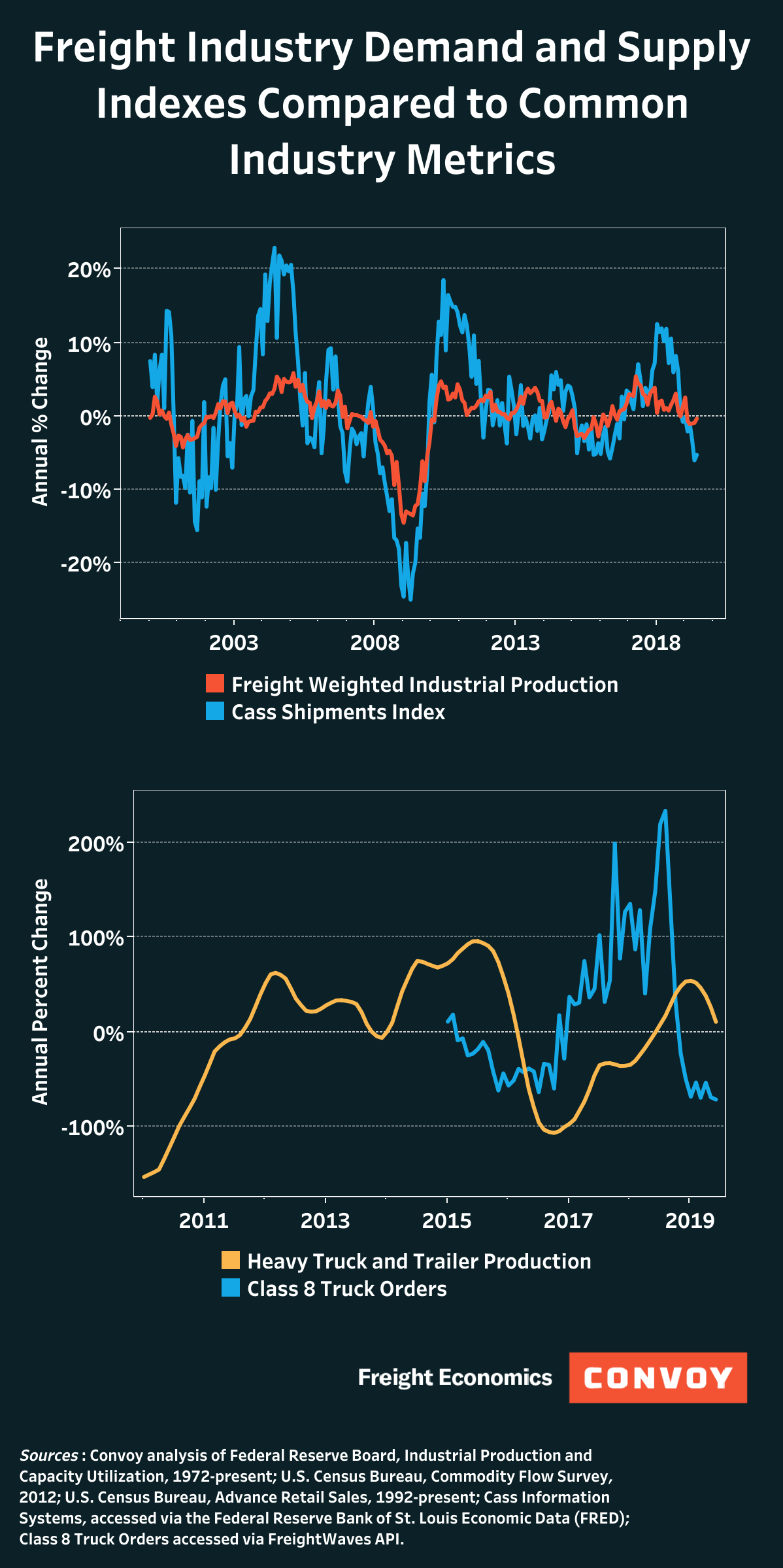No one quite knows what the lasting impacts of the coronavirus pandemic will be for the freight industry. If past crises are any guide, moments of crisis tend to accelerate shifts that were already underway. But there are also points of continuity. Today we’re sharing the third of our twice weekly video series featuring Ari…
Category: Freight Research
Coronavirus and Freight: Market Outlook Video (March 26, 2020)
This has been a rollercoaster of a week and it’s not even Friday. Financial markets recorded record losses on Monday, record gains on Tuesday, and another big increase on Wednesday. Will the proposals being considered in the nation’s capital be enough to sustain the economy while businesses are shuttered and states on lockdown? Today we’re…
Coronavirus and Freight: Market Outlook Video (March 24, 2020)
There’s no shortage of media coverage about COVID-19’s broad impacts. We hear from our shippers and from the carriers in our network that there’s an appetite for analysis on what the current coronavirus outbreak means for supply chains and for the freight industry from the perspective of a Digital Freight Network. That’s why today we’re…
COVID-19 and Freight: What’s next for demand? Will truck supply contract?
Earlier this week we shared our initial thoughts on the freight market given the volatile economic environment of the past two weeks. In moments of great uncertainty there is, by definition, more noise than signal. Our goal is not to add to the noise, but to simply state facts about the freight market and the…
Ancient History: February Industrial Production and Retail Sales
This morning the Federal Reserve Board published February Industrial Production data and the U.S. Census Bureau published February Retail Sales. During normal times, this data would provide the first official pulse on the state of freight demand. These are, of course, anything but normal times. The sudden market shift over the first half of March…
Occupational Licenses as a Barrier to Exit for Skilled Workers
Carrier bankruptcies over the past year have sparked some fears about whether there will be enough truck drivers when freight demand eventually rebounds. The freight industry is cyclical and the market can quickly shift. But fears that recent bankruptcies among trucking companies will prompt meaningful numbers of drivers to seek jobs in other industries may…
Trucking does not have a driver retention problem; trucking companies do
An abbreviated version of this article appeared on Trucks.com in February 2020 Driver turnover is notoriously high in the freight industry — with some estimates suggesting that, on average, trucking companies see their entire driver pool change over each year. Such eye-poppingly high turnover statistics would suggest a massive labor retention crisis. In a year…
Global Supply Chain Disruptions Derail Expected Rebound in January Industrial Output
Industrial production continued to disappoint in January, dashing late-December hopes of a new start for the U.S. economy in the new year. The sectors with the biggest trade exposure (e.g., industrial manufacturing) faltered while the sectors that rely on domestic consumption (e.g., food and beverage, furniture and appliances) were rare points of strength. Unseasonably warm…
With Trade Tensions Resolved, December Data are Old News
The freight economy continued to contract in December, capping a year of steady retrenchment in truckload demand according to data released this morning by the Federal Reserve Board. The data came in soft, in line with expectations. Some of this can be written off to an unseasonably warm start to winter across much of the…
Was November a Turning Point for Freight Demand?
With today’s November industrial activity data, it’s likely that the worst of the freight recession is now squarely in the rearview mirror. The November report was a clear improvement from October, though it’s important to keep some caveats in mind. It was always going to be easy to beat October: The closing days of the…
The 2020 Outlook for the Freight Industry
This week Convoy hosted a webinar looking back at the key market forces driving the freight industry in 2019, and explored how unresolved questions from the past year might shape the market going into 2020. There remain substantial uncertainties about the economic outlook for the coming year. To some degree, there always are. But for…
Soft October Industrial Activity Points to a Two-Speed American Economy
Industrial activity was soft in October, posting its second consecutive year-over-year decline. Some of the results can be written off to one-off factors — the residual effects of the General Motors strike that ended mid-month, and a strong comparable for October 2018. The economy faced a number of headwinds in September that weighed on industrial…
One-Off Factors Weigh Down September Industrial Activity
Industrial activity was weak in September, buffeted by adverse weather, tough times in farm country, labor disruptions, and the continuing trade war. After posting a modest rebound in August, industrial production hit another rough spot in September and was down 0.16 percent from a year earlier. Manufacturing and consumer goods showed even sharper declines. But…
Automated Reloads Are Reducing Empty Mile Carbon Emissions by 45%
Today, Convoy is proud to share that bundling loads through our Automated Reloads program is yielding a 45% decrease in CO2 emissions from trucks running empty less often. Launched nationwide in June, Automated Reloads algorithmically groups multiple full-truckload shipments for carriers — minimizing empty miles, eliminating time wasted between loads, and lowering the resulting unnecessary…
Quantifying a Greener Future for Freight
This post was originally published on Convoy’s Tech Blog on Medium There is a dirty secret in the freight industry. According to the U.S. Environmental Protection Agency (EPA), medium- and heavy-duty truck freight accounts for 7 percent of all U.S. greenhouse gas emissions, or 436.5 million metric tons of CO2 equivalent in 2017 (the most recent year of data…
Freight Recession Continues Despite Stronger Industrial Production Data
The freight economy remains in the midst of a recession despite stronger-than-anticipated industrial activity in August. Industrial Production data published this morning by the Federal Reserve Board Industrial Production were a welcome relief for anyone looking for a break from a recent string of soft manufacturing numbers. Still, despite the August pickup, factory activity is…
The Most Visited Truck Stops in the Lower 48
When you drive a heavy truck, highways are your second home and many truckers have strong preferences for where they stop their rigs. Inspired by American Trucking Association’s National Truck Driver Appreciation Week, we identified the truck stop in every state most visited by our community of tens of thousands of carriers. When carriers turn…
Freight Industry Recessions and the Business Cycle
The freight industry is currently experiencing a recession, which began in October 2018. From peak to peak, the freight industry typically experiences a full industry-specific business cycle about every four years; the typical freight recession lasts around 10 months. While freight industry downturns often lead macroeconomic downturns by several months, about half of freight industry…
Identifying the Freight Industry Business Cycle
To identify freight industry expansions and recessions, our goal was to replicate as closely as possible common approaches used to identify the business cycle for the broader economy. There is no universally accepted definition of a recession. The National Bureau of Economic Research (NBER) — a nonprofit that is the most authoritative arbiter of U.S.…
What you need to know about empty miles in trucking
Waste matters. For nearly every industry, waste contributes to higher costs. But in the freight industry, the stakes are even higher. In freight, waste means that more fuel is consumed, more carbon is emitted, and drivers spend more hours sitting idle. Empty miles are the primary form of freight waste. One of the most common…










